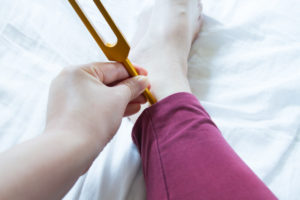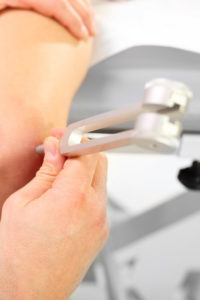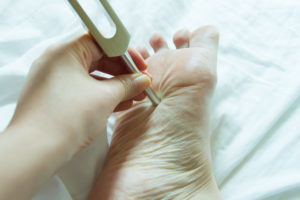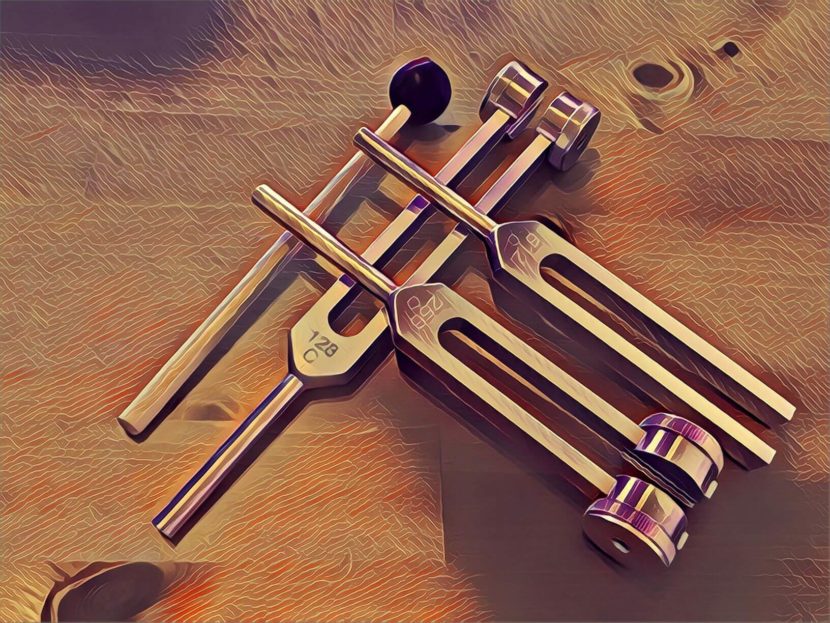Tuning fork therapy is a fascinating practice harnessing the power of sound and vibration to promote physical and emotional well-being. By striking these specialized forks and holding them against various points on the body, practitioners unlock a world of healing potential.
There are a number of therapies and wellness regimens that tuning fork self-therapy could have an effect in such as:
- Pain control
- Getting mentally “unstuck”
- Stress
What exactly, though, is tuning fork therapy. How can it benefit you?
We will explore different striking techniques used to produce specific frequencies that resonate with our bodies’ natural rhythms. Moreover, we will uncover the myriad benefits of incorporating tuning forks into your wellness routine. Whether you are seeking relief from specific symptoms or simply aiming to enhance your overall health, this alternative health maximization method offers a holistic approach worth exploring.
If you’re ready to embark on an extraordinary journey toward self-healing and rejuvenation, let’s dive deeper into the world of tuning fork therapy.
How tuning forks work for healing
The science behind tuning forks and healing
Tuning forks have been used as a tool for healing for years, mainly in Asia.
Vibrations and energy systems

When a tuning fork is struck against a surface, it produces a specific frequency or vibration, the “tune.” This is called vibrational resonance. Each fork is designed for a particular frequency, for example, 128 Hz, or 256 Hz. This vibration creates sound waves that travel through the air. They reach our ears and allow us to hear the sound. However, the impact of these vibrations extends beyond our auditory experience.
We have a physical body as well as an energy body. The energy body reflects our overall well-being similar to the way our physical body does.
Think of what you think when you see someone who looks ashen. They’re not healthy, right? You wonder why they’re so pale. Could it be because of heavy blood loss? Are they missing iron in their diet? Is their heart not pumping well?
The energy body also gets affected by our overall health. When we introduce the vibrations of a tuning fork into these energy systems at junctures in the body known as meridians, something remarkable happens. The frequencies emitted by tuning forks can restore balance to our energy systems. Each energy system corresponds to different organs or areas of the body. By targeting specific points with the appropriate frequency, tuning forks stimulate these areas and promote healing.
Think of a guitar or piano being tuned. When you “groove” with a tuning fork, you’re restoring balance to the energy body. The body, too, is a type of instrument.
Entrainment
One key concept in understanding how tuning forks work is entrainment. Entrainment refers to the synchronization or harmonization of energies between two objects or systems. When two objects vibrate at different frequencies, they naturally adjust themselves until their vibrations align.
In the context of tuning fork therapy, entrainment occurs when the body’s energy system resonates with the frequency produced by the tuning fork. The body essentially “tunes in” to this frequency and begins to synchronize its own vibrations accordingly.
This process helps bring balance back to any disrupted energy patterns within our bodies. It encourages stagnant or blocked energy to flow freely again, promoting physical and emotional healing.
Exploring tuning fork therapy techniques
Now that we understand the theory of how tuning forks work, let’s explore some common techniques used in tuning fork therapy:
-
Acupressure Points: Tuning forks can be applied to specific acupressure points on the body to stimulate energy flow and alleviate pain or discomfort.
-
Chakra Balancing: When a person’s aura is photographed, different layers of energy are visible. These layers have come to be called chakras. Each chakra is associated with a different frequency. By using tuning forks tuned to these frequencies, practitioners can help balance and harmonize the chakras.
-
Sound Bath: A sound bath involves creating a soothing environment by playing multiple or singular tuning forks. The vibrations from these forks envelop the individual, promoting relaxation and stress reduction.
Tuning fork therapy offers a unique approach to healing by harnessing the power of vibrations and energy systems within our bodies. As we’ve explored, the science behind this practice is rooted in the principles of entrainment and balancing energies.
By understanding how tuning forks work for healing, we can appreciate their potential benefits and consider incorporating them into our wellness routines.
How tuning forks can help you
Tuning forks can be a standalone or adjunctive therapy. They can be used to treat a wide variety of other conditions alongside a number of other therapies both conventional and alternative.
They can help with a lot of problems that deal with some kind of imbalance, like stress, headaches, chronic health issues, and muscle pain.
It really is a wide variety of conditions. For example, one could get stressed out because they lose their job. The stress leads to headaches because they’re too worried to eat, plagued by worry about paying their bills, worried about people thinking less of them because they’re unemployed, and worried about finding another job. How listening to some tones from these metal instruments can help isn’t immediately obvious.

But they can. The sufferer would close their eyes and listen to the pitch of the 512 Hz until it stopped vibrating and then 20 seconds longer. They then might try the 128 Hz on the designated points on the head and face. While they won’t lead directly to the person getting a new job and relieving financial pressure, they could provide a mental reset where the person may approach his or her problems with a freshened orientation.
It’s not really a whole lot different from how someone might go out dancing or to hear a band to forget their problems.
Tuning forks would be contraindicated in cases where sound wave conduction would be affected such as osteoporosis (due to the structure of the bone), osteopenia, fractures (definite sprains and strains should be okay), and metal implants like pacemakers and artificial joints. Often they wouldn’t be harmful, but, rather ineffective due to conduction.
The role of tuning forks in sound healing
Toning
One technique commonly used in tuning fork therapy is toning. Toning involves using specific frequencies produced by tuning forks to create harmonious sounds that resonate with different parts of our body. By placing the vibrating forks on various acupressure points or energy centers, practitioners can stimulate the flow of energy and restore balance within.
Therapeutic benefits
The therapeutic benefits of tuning fork therapy extend beyond the physical level. Sound vibrations have been shown to have a profound impact on our emotional and spiritual well-being as well.
-
Physical: The gentle vibrations produced by tuning forks can help relax muscles, reduce pain and inflammation, and improve circulation. This can lead to enhanced physical healing and overall wellness.
-
Emotional: Sound healing with tuning forks has been known to promote deep relaxation, reduce stress and anxiety, and improve mood. The soothing sounds can create a sense of calmness, allowing individuals to release emotional tension and find inner peace.
-
Spiritual: Many practitioners believe sound vibrations can connect us with God (or what some might call a “higher consciousness”), similar to the way you might listen to music in church. By creating a harmonious environment within our bodies, tuning-fork therapy can facilitate spiritual growth, intuition, and self-awareness.
Step-by-step guide: Using tuning forks for energy healing
Activating tuning forks
-
Hold the tuning fork by its stem, ensuring a firm grip.
-
Gently tap the prongs of the tuning fork against a rubber mallet or your knee to activate it.
-
Allow the sound to resonate and fill the space around you.
- For best results, allow the fork to completely finish vibrating before hitting it with a mallet again. Patience! Some of the forks will vibrate for a longer time than others.
Holding and applying tuning forks
-
Listen closely to the fork to familiarize yourself with its unique sound.
-
Place the base of the tuning fork on specific acupressure points or on those of another person. The points and what parts of the body they can alleviate can be found on charts like this one and this one.
-
Apply gentle pressure while holding the tuning fork against these points.
Discovering effective points for healing
- It helps to have a general idea of where different pertinent acupuncture or acupressure points are located. Use a chart or app to locate them.
Using tuning forks during self-healing:
- Find a quiet space where you can relax without distractions.
- Sit comfortably or lie down in a relaxed position.
- Close your eyes and take a few deep breaths to center yourself.
Applying tuning forks on others:
- Ensure both you and the recipient are comfortable before beginning any healing session.
- Communicate about preferences regarding touch sensitivity or areas they would like you to focus on during treatment.
By following this step-by-step guide, you can effectively incorporate tuning forks into your healing journey or assist others in their quest for wellness. Whether you are using them for self-healing or as a healing practitioner, proper techniques and knowledge of specific points on the body will maximize the effectiveness of tuning fork therapy. Embrace the power of sound vibrations and experience the profound impact they can have on your well-being.
Create a safe and effective environment
-
Find a quiet and peaceful space in your home where you can practice tuning fork therapy without distractions.
-
Ensure that the room is clean and clutter-free to help you relax.
-
Consider using soft lighting or candles to enhance the ambiance.

Important precautions
-
Tuning fork therapy is for minor medical conditions and for wellness. Don’t use them to address a pain that started quickly.
-
If you have any chronic illnesses or are under medical treatment, consult with your healthcare provider before incorporating tuning fork therapy into your routine.
-
Do not use tuning forks directly on broken skin, wounds, or areas of inflammation. It’s best to avoid these areas altogether during the session.
-
Be mindful of the intensity and duration of each session. Start with shorter sessions and gradually increase as needed. Pay attention to any discomfort or adverse reactions during or after the therapy.
Proper handling of tuning forks
-
Hold the stem of the tuning fork firmly between your thumb and forefinger. This allows for better control when activating it.
-
When striking the fork, gently tap with the small mallet. Avoid hitting it too hard.
-
After each use, wipe down your tuning forks with a clean cloth to remove any oils, dirt, or debris. Keeping them clean helps maintain their effectiveness.
Cleaning and maintenance
-
Regularly inspect your tuning forks for any signs of wear or damage. Check if there are cracks in the metal prongs or if they have become loose over time.
-
To clean the tuning forks thoroughly, prepare a solution of warm water mixed with mild soap or dish detergent.
-
Dip a soft cloth into this solution and gently wipe down each tuning fork prong until it is clean. Avoid submerging the forks in water or using abrasive cleaners.
-
Rinse the tuning forks with clean water to remove any soap residue and pat them dry with a towel.
-
Store your tuning forks in a protective case or pouch to prevent dust accumulation and potential damage.
- Classes teaching an advanced understanding of tuning fork therapy are available. Applying tuning forks to experiment with their effectiveness in alleviating pain is generally safe if these instructions are followed closely. Nevertheless, these instructions are no substitute for working with a certified professional, taking a hands-on class, or even one conducted online. Some providers of instruction in tuning fork therapy are the Acutonics Institute of Integrative Medicine, Tuningforktherapy.org, and the Academy of Sound Healing.
Some tips:
-
Wipe down your tuning forks with a soft cloth before and after each use.
-
Use intention and focus during your tuning fork sessions to enhance the healing process.
-
Experiment with different frequencies and chakra points to find what works best for you.
Vibrational resonance
Scientific research supporting tuning fork therapy
While some may view tuning fork therapy as purely alternative or complementary medicine, there is scientific research supporting its effectiveness in certain areas. Studies have shown positive results in pain management and stress reduction when using tuning forks.
A study published in Holistic Nursing Practice found patients who received vibrational therapy using tuning forks experienced significant reductions in pain intensity compared to those who did not receive this treatment. The researchers suggested that this could be attributed to the ability of vibrations to stimulate nerve endings and promote relaxation.
Another study published in the Journal of Advanced Nursing explored the effects of tuning fork therapy on stress reduction. The findings indicated that participants who received this therapy experienced lower levels of stress and improved overall well-being compared to those in the control group.
Tuning forks were also studied for their ability to detect fractures. While they had some success, they were judged to not be accurate enough for clinical use.
While more research is needed to fully understand the mechanisms behind tuning fork therapy, these studies provide promising evidence for its potential benefits.
Intention in Tuning Fork Therapy
Amplify healing effects with intention-setting
Setting intentions can have a profound impact on the healing effects of tuning fork therapy. By consciously directing your focus and energy towards specific outcomes, you enhance the overall experience and promote deeper healing. Whether you are a practitioner or someone receiving the therapy, incorporating intention-setting techniques can elevate the effectiveness of your sessions.
Techniques to enhance intention-setting
To maximize the power of intention in tuning fork therapy, consider these techniques during your sessions. They’re really not very different from any intention-setting practice. For example, hitting a baseball (“imagine yourself making contact with the baseball and being successful”):
-
Clear your mind: Before beginning a session, take a few moments to clear your mind and create a focused space for intention-setting. This allows you to connect more deeply with your desired outcome.
-
Visualize your intention: Close your eyes and visualize what you intend to achieve through tuning fork therapy. Imagine yourself already experiencing the desired outcome, whether it’s reduced pain, increased relaxation, or improved energy flow.
-
Use affirmations: Incorporate positive affirmations related to your intention into your practice. Repeat them silently or aloud during the session to reinforce your desired outcome. As with the baseball example, it pays to think you can, rather than think “this is stupid.”
-
Connect with energetic pathways: Tune into the energetic pathways within your body by focusing on specific points where you want to direct healing energy. Use this awareness to guide the vibrations of the tuning forks toward those areas. Don’t be afraid to use your intuition.
-
Engage multiple senses/tools: Engaging multiple senses can amplify intention-setting in tuning fork therapy. Consider using essential oils, soothing music, or gentle lighting to potentiate the effects.
The positive influence of focused intention on energetic outcomes
When you set focused intentions during tuning fork therapy sessions, you tap into the power of conscious manifestation and influence energetic outcomes positively:
-
Enhanced energy flow: By directing your intention towards clearing energetic blockages and promoting a smooth flow of energy, you can help restore balance and harmony within the body.
-
Reduced pain and Discomfort: Intention-setting can also aid in reducing pain and discomfort by focusing on specific areas that require healing. By channeling your intention towards these areas, you enhance the vibrational impact of the tuning forks.
-
Increased Relaxation: When your intention revolves around relaxation and stress reduction, tuning fork therapy becomes an even more potent tool for achieving deep states of calmness. The vibrations from the forks resonate throughout your body, promoting relaxation on a physical and energetic level.
-
Emotional Healing: Focused intention can support emotional healing by directing vibrations toward areas associated with emotional imbalances or trauma. This intentional approach facilitates release, allowing emotional wounds to heal more effectively.
Incorporating focused intention into tuning fork therapy sessions empowers both practitioners and recipients to harness the full potential of this modality.
By aligning your intentions with the desired outcomes during each session, you create a space for profound healing experiences that go beyond the physical realm.
Ideas for self-care practices with tuning forks
-
Daily tune-up: Set aside a few minutes each day for a personal tuning fork session. Strike the fork against an activator and hold it near your ears, allowing the vibrations to permeate your entire being. This simple practice can help alleviate stress, improve focus, and enhance emotional well-being.
-
Stress relief on the go: Carry a small unweighted tuning fork in your bag or pocket for quick stress relief throughout the day. Whenever you feel overwhelmed or anxious, take a moment to tap the fork against an activator and listen to its gentle hum as it brings you back to a state of calm.
-
Pain Relief: Target specific areas of discomfort by using weighted tuning forks directly on the affected body part. Gently strike the fork and place it on pressure points or areas experiencing pain to help alleviate tension and promote natural healing.
Conclusion
Tuning fork therapy offers a unique and effective approach to holistic healing. By understanding how tuning forks work, exploring different frequencies, and utilizing techniques in sound healing, this therapy has shown promising results in promoting overall well-being.
One of the key benefits of tuning fork therapy is its ability to induce vibrational resonance in the body, which can help restore balance and harmony. When used with intention and combined with other modalities, such as meditation or energy work, the healing effects can be amplified.
Not only does tuning fork therapy have physical benefits, but it also aids in reducing stress and improving emotional well-being. The power of sound vibrations can create a sense of relaxation and calmness, allowing individuals to find relief from daily pressures.
Moreover, tuning fork therapy extends beyond personal healing. It can be used to clear spaces energetically and promote positive environments. Whether you are seeking self-care or looking for ways to enhance your living space, tuning forks offer a versatile tool for various purposes.
To incorporate tuning fork therapy into your life, consider practicing at home while following safety precautions. By using tuning forks correctly and with proper guidance, you can experience the potential benefits firsthand.
FAQs
Can anyone practice tuning fork therapy?
Yes! Tuning fork therapy is accessible to anyone interested in exploring alternative methods for holistic healing.
Are there any side effects or risks associated with tuning fork therapy?
When used correctly following safety guidelines, tuning fork therapy is generally safe without any significant side effects or risks.
How long does it take to experience the benefits of tuning fork therapy?
The duration for experiencing the benefits of tuning fork therapy varies from person to person. Some individuals may notice immediate effects, while others may require multiple sessions for optimal results.
Can tuning fork therapy be used alongside other medical treatments?
Tuning fork therapy can complement conventional medical treatments, but it is essential to consult with a healthcare professional before integrating it into your existing treatment plan.
Are tuning forks suitable for children and older adults?
Yes, tuning forks can be used by people of all ages. However, it is advisable to exercise caution and adjust techniques accordingly when working with children or older adults.
How often should tuning fork therapy be practiced?
The frequency of tuning fork therapy sessions depends on individual needs and preferences. It can be practiced as frequently as desired or as recommended by a qualified practitioner.
Where can I find reliable resources and practitioners for tuning fork therapy?
To find reliable resources or practitioners specializing in tuning fork therapy, consider seeking recommendations from trusted sources within your local community or conducting online research to ensure credibility.
Boyd-Brewer, C., & McCaffrey, R. (2004). Vibroacoustic sound therapy improves pain management and more. Holistic nursing practice, 18(3), 111–119. https://doi.org/10.1097/00004650-200405000-00002
Also on the blog:
James Cobb RN, MSN, is an emergency department nurse and the founder of the Dream Recovery System. His goal is to provide his readers with simple, actionable ways to improve their health and maximize their quality of life.
We use some affiliate links. If you click on a link and make a purchase, we may receive a commission. This has no effect on our opinions.
